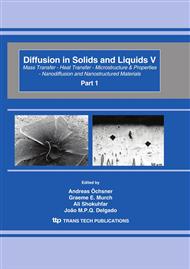p.1262
p.1267
p.1284
p.1290
p.1295
p.1301
p.1306
p.1312
p.1322
Influence of Elements Oxides Microadditives with Major Cationic Radius on Properties of Silicate Bundle
Abstract:
For the agglomerates of the Kachkanar deposit iron ore the role of elements with ionic radius larger than for magnesium and calcium in the formation of the strength characteristics and parameters of the viscous-plastic state of iron-ore materials is shown. The strength characteristics of high-quality sinters are largely defined by the low stressed state of a silicate bundle which is formed in the cake cooling-down period. The diffusion processes at the glasses recrystallization at the cakes refrigeration can be reduced by injection of the elements impeding these processes and having low -strength cation-oxygen connections, that, apparently, should ¬ hinder in formation of the crystals with their participation. From these positions the stabilizing additions are the cations of heavy elements having major radius and remote from the valence electrons¬. It according to the theory of the stressed state of the oxide ¬ systems is accompanied by the grain refinement, decrease of the microstresses ¬ and fissurings of the glass matrix and therefore the defectiveness of cake structure. On the basis of the mathematical model leaning on the results of the dilatometric explorations the positive influence of the microadditives of the barium oxide on increase of temperature of beginning and narrowing of the softening range of sinters is revealed.
Info:
Periodical:
Pages:
1295-1300
Citation:
Online since:
April 2010
Authors:
Price:
Сopyright:
© 2010 Trans Tech Publications Ltd. All Rights Reserved
Share:
Citation:


